I always follow with interest and with a smile the threads here and all over social media about drying wood. Books can be written about all the methods people use to store wood, to dry rough turned blanks. To spalt the wood, and more. I'm blessed where I live a few miles from the Island's rainforest, so I have no problem drying wood, is always humid. But, I had something happen that I wanted to share. Believe it or not, I still have some of the original Koa that got me into woodturning. That was well over 25 years ago. Just about every branch was curly, it was a Big Island Koa, growing in my yard. I cut up a nice log into 3 sections to make Urns. Endgrain turning. I normally would have sealed the ends with Anchor seal. But, I figure this tree is super dry. At one inch per year, is more than dry. Within a few days, the end grain cracked. Just like a green freshly cut log would. Moral of the story is, even after 25 years, in a humid climate, seal your ends.
-
November Turning Challenge: Puahala Calabash! (click here for details) -
Sign up for the AAW Forum Pre-Holiday Swap by Monday, November 4th (click here for details) -
Congratulations to Ted Pelfrey for "Forest Floor" being selected as Turning of the Week for November 4, 2024 (click here for details) -
Welcome new registering member. Your username must be your real First and Last name (for example: John Doe). "Screen names" and "handles" are not allowed and your registration will be deleted if you don't use your real name. Also, do not use all caps nor all lower case.
You are using an out of date browser. It may not display this or other websites correctly.
You should upgrade or use an alternative browser.
You should upgrade or use an alternative browser.
Drying Wood
- Thread starter Emiliano Achaval
- Start date
I'd say this might be a good example of "equalibrium moisture content" and is a good reminder that the ambient atmosphere is very important when it comes to drying wood. Great story. Thanks!
I have had a similar experience with black walnut many times when I received unmilled log or crotch or root pieces that had been stored for up to 40 years and when cut into were still wet or not at equilibrium moisture. The inch per year rule is for air drying of milled lumber and that is limited to 3 to 4" depending on the species. The other point to consider is will the wood rot away if it is not dried?
I find it interesting that many turners describe cutting large chunks/log sections and letting them “dry” several years before turning. Doesnt happen.
I was hollowing out a large elm bowl from a blank that had been sealed and drying for over 20 years. I turned my back to sharpen the gouge when I heard
a strange "thump" sound. The bowl had split from the rim almost to the base.
I think the blank must have come from near the top of the main trunk where it branched. I just released the tension that was present.
Last year I acquired some oak logs from neighbours when they cut down a tree. I rough turned some large bowls (after saving the cores using a McNaughton centre saver) and
sealed the outsides before drying in paper bags. The large bowls checked severely and are beyond salvaging. That's the last time I'll bother with oak. I have never experienced
that with other woods.
a strange "thump" sound. The bowl had split from the rim almost to the base.
I think the blank must have come from near the top of the main trunk where it branched. I just released the tension that was present.
Last year I acquired some oak logs from neighbours when they cut down a tree. I rough turned some large bowls (after saving the cores using a McNaughton centre saver) and
sealed the outsides before drying in paper bags. The large bowls checked severely and are beyond salvaging. That's the last time I'll bother with oak. I have never experienced
that with other woods.
Every wood is different, and some are more different than others.... I figure that drying creates stress, and the idea is to control that stress so it doesn't result in stress relief, which is cracking... Don't turn oak much, just don't care for it. One of the most secure ways I have heard of drying difficult woods is paper bag inside a plastic bag, and change out the paper bag every day. Drying our wood is another art that we have to try to master....
robo hippy
robo hippy
I turn a fair amount of Oak. it’s plentiful where I live and I found myself with a lot of it. In truth, I wasn’t excited about working Oak, but once I got into it I really started enjoying the work. Bowls made of Oak seem so tough—lifetime bowls. So, best to figure it out was my thinking.
It moves a lot, and loves to crack, as you know. The fatal cracks seem to happen shortly after rough turning.
I had turned three red oak bowls—12 to 14 inches—and coated them liberally with anchorseal before going to the beach for a week. So sad to see two of them had cracked in such a short time. And this is during a North Carolina summer with all of our humidity.
After some studying and pondering I decided that the rims shrink too quickly and pull too hard till “Bang!”
This is my solution, or my experiment. I coat the entire bowl with anchorseal, then cover the rim (or any other high stress, crack generating areas) with strips of blue paper towel, then slather more sealer on the bandages. Then dry as usual. I store my ‘in process’ bowls on wire rack shelves (stated for reference). 50 or 60 bowls later with zero breakage.
It moves a lot, and loves to crack, as you know. The fatal cracks seem to happen shortly after rough turning.
I had turned three red oak bowls—12 to 14 inches—and coated them liberally with anchorseal before going to the beach for a week. So sad to see two of them had cracked in such a short time. And this is during a North Carolina summer with all of our humidity.
After some studying and pondering I decided that the rims shrink too quickly and pull too hard till “Bang!”
This is my solution, or my experiment. I coat the entire bowl with anchorseal, then cover the rim (or any other high stress, crack generating areas) with strips of blue paper towel, then slather more sealer on the bandages. Then dry as usual. I store my ‘in process’ bowls on wire rack shelves (stated for reference). 50 or 60 bowls later with zero breakage.
Attachments
For any bowl of any wood, and certainly oak - rough turn and cover the rim around the OD with stretch wrap, then bag it. I do it for 1 or 2 turn bowls. 6” wide stretch wrap on a handle. Credit to @robo hippy for this approach.
Yes people keep bringing up the one inch per year for drying wood, but this applies only for construction soft wood, the SPF species, and as was said before even that holds up only for 2 by 4 or wider and at the most 4 inches that then very often still splits, ever seen a 4X4 without splits, it is pretty rare, especially with the pith in it as often is the case.
Hardwood takes at least double that time and depending the species even longer and again and again only for thinner slabs like up to 4 inches thick.
And as I have said many times before, rough turn that fresh green wood before trying to dry it, and never out in the open air, does not matter how humid the air is, where I say, hang a towel to dry in this humid air and a few hours later it is dry, or as dry as it can get, your wood will dry too fast set out in the open air, period.
I am not going by what some one said, like I heard this or that, from so and so, I have been turning for a loooong time, and learned what works nearly flawless (NEARLY I said).
Start with fresh green wood without any checks or splits.
Rough turn in one go and stick it in a brown paper bag, set it away in a cool place indoors, and check it the first week or so to see if any mildew has grown on it (if any, wipe it off and place the turning in a dry bag)
Done this way I have a 98% success rate, be it Apple Oak Mulberry etc, it works.
Hardwood takes at least double that time and depending the species even longer and again and again only for thinner slabs like up to 4 inches thick.
And as I have said many times before, rough turn that fresh green wood before trying to dry it, and never out in the open air, does not matter how humid the air is, where I say, hang a towel to dry in this humid air and a few hours later it is dry, or as dry as it can get, your wood will dry too fast set out in the open air, period.
I am not going by what some one said, like I heard this or that, from so and so, I have been turning for a loooong time, and learned what works nearly flawless (NEARLY I said).
Start with fresh green wood without any checks or splits.
Rough turn in one go and stick it in a brown paper bag, set it away in a cool place indoors, and check it the first week or so to see if any mildew has grown on it (if any, wipe it off and place the turning in a dry bag)
Done this way I have a 98% success rate, be it Apple Oak Mulberry etc, it works.
Jim McLain
Artist
Everyone develops their own method of dying blanks. My self living in New Mexico where the relative humidity has been 5% or less most of the year it has its challenges. I only turn green wood in the fall when the humidity is a little higher. I soak my blanks in Pentacryl for a week then box them up for six months to a year. I still get some failures but am happy with my overall success rate. Prior to Pentacryl I tried End grain sealer, PEG, dish soap and denatured alcohol.
The above discussion focused on bowls, and I've had my share of cracks here in Colorado. But I've got a question that will take us a little off topic. I do a lot of small stuff with 1/8" - 3/16" walls -- birdhouse ornaments, 3" hollow balls with finials, lidded boxes, and the like. I do use a fair amount of green wood, but I turn, hollow, sand, and finish with 2 or 3 coats of lacquer all in one session. So far I haven't had a cracking issue with this kind of work. Am I just lucky? Does size matter? Is it because it's end-grain turning? Or is the trick to finish immediately with a surface finish?
seems like the 'one year per inch' idea ought to be retired. Life and wood is always way more complicated than the rules-of-thumb we want to live by.
There is an article in the current issue of American Woodturner that I found intriguing: "Using Silica Desiccant to Dry Rough-Turned Bowls" by John Stielher. The rough-turned bowl is buried in silica desiccant in a plastic bag. It is reported not only that it works, but that it dries the rough-turned bowl in a few days and with less cracking than other methods. If this works, it could be a game-changer.
I hope/expect that you do condition the indoors of your house, where the humidity would be better than the outside one , maybe your shop as wellEveryone develops their own method of dying blanks. My self living in New Mexico where the relative humidity has been 5% or less most of the year it has its challenges. I only turn green wood in the fall when the humidity is a little higher. I soak my blanks in Pentacryl for a week then box them up for six months to a year. I still get some failures but am happy with my overall success rate. Prior to Pentacryl I tried End grain sealer, PEG, dish soap and denatured alcohol.
In that case maybe that is where you should dry and condition your rough turned bowls, that would give you a better outcome i'dd expect
Yes size does matter, and with engrain boxes etc., it has not the engrain in part of the wall and long grain in the other part of it, like in a bowl, where the engrain would dry at 10 times the speed of the side grain, and this is where the tension happens, that is why I bag my green turning and with the total saturation of the air inside the bag the drying is going to be the same for all parts of the piece.The above discussion focused on bowls, and I've had my share of cracks here in Colorado. But I've got a question that will take us a little off topic. I do a lot of small stuff with 1/8" - 3/16" walls -- birdhouse ornaments, 3" hollow balls with finials, lidded boxes, and the like. I do use a fair amount of green wood, but I turn, hollow, sand, and finish with 2 or 3 coats of lacquer all in one session. So far I haven't had a cracking issue with this kind of work. Am I just lucky? Does size matter? Is it because it's end-grain turning? Or is the trick to finish immediately with a surface finish?
With boxes I would expect the top and bottom to check if the drying was not controlled, not the walls, with applying the lacquer the engrain is then not able to dry as fast and it will help for not checking, I do similar with CA, and use that also on knots, by filling the knot's grain with CA it prevents the shrinking of that knot, I have good results doing that, not a 100% but pretty close
Leo, are you saying when you rough turn a bowl with a knot, you coat the knot with CA, then bag it as you usually do?I do similar with CA, and use that also on knots, by filling the knot's grain with CA it prevents the shrinking of that knot, I have good results doing that, not a 100% but pretty close
- Joined
- Apr 27, 2004
- Messages
- 8,977
- Likes
- 5,475
- Location
- Lakeland, Florida
- Website
- www.hockenberywoodturning.com
I just lucky? Does size matter? Is it because it's end-grain turning? Or is the trick to finish immediately with a surface finish?
birdhouse ornaments, 3" hollow balls with finials,
Size, wall thickness, and shape matter. Species too.
Green hollow forms regardless of size almost never crack with nice curves and an even wall thickness of 3/16 or less.
Hard to turn anything smaller than 3” diameter that will crack. The magnitude of the wood movement is small.
A 15” diameter piece the wood movement is many times larger. If the wood species shrinkage is 5% radially the 3” piece shrinks .15” radially and the 15” piece shrinks 3/4”. That larger movement creates larger stresses.
I have turned quite a few balls 2.5-3 diameter from green live oak. I just set them on shelves. They don’t crack because the wood can move as it dries into these nice ovoids.
I dry lots of spindle stock.
2x2 no loss. 3x3 very little loss. 4x4 Will crack 30% of the time.
Last edited:
Marc, interesting solution for rim treatment. As near as I can tell, I was the first person to use the stretch film on the rims of bowls for drying. Not sure how it would work for oak since I don't turn much of it. You all know engineers, "if it ain't broke, take it apart and fix it anyway"..... I would have rounded over the rims a bit more on that piece. I never twice turn pieces because I like the warped shapes. Some cylinders I turn, up to maybe 4 inch diameter, I will coat the ends with Titebond. I have half of a gallon left with a big lump in it that I added a bit of water to and stirred vigorously. I sealed the end grain on some honey locust, which loves to crack, and thus far the log sections have not cracked any more. It has been very cool and damp here....
As for the drying method for slabs, I had thought it was 1 year per inch of thickness, outside, then bring it into the shop for at least 6 more months. So, outside brings it some where near equilibrium, and indoors gets it down closer to ready for furniture dryness. If I was processing a lot of lumber, I would build a solar kiln. One guy locally lets his madrone sit under tarps and straps for a year, then into the solar kiln. The idea is that the sun heats up the wood a bit, then at night, the cooling 'relaxes' the wood to relieve stress. I do love the way it works for furniture making...
robo hippy
As for the drying method for slabs, I had thought it was 1 year per inch of thickness, outside, then bring it into the shop for at least 6 more months. So, outside brings it some where near equilibrium, and indoors gets it down closer to ready for furniture dryness. If I was processing a lot of lumber, I would build a solar kiln. One guy locally lets his madrone sit under tarps and straps for a year, then into the solar kiln. The idea is that the sun heats up the wood a bit, then at night, the cooling 'relaxes' the wood to relieve stress. I do love the way it works for furniture making...
robo hippy
Marvin I do the green rough turning and soak thin CA into the knot, as much as it will take, and then the piece goes into the paper bag, and most knots will not split, some will just a little, but hardly any will split right open.Leo, are you saying when you rough turn a bowl with a knot, you coat the knot with CA, then bag it as you usually do?
I pulled some pictures that show the dried rough turned piece with the CA showing and then also finished.
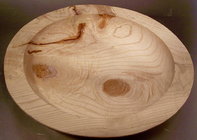
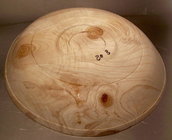
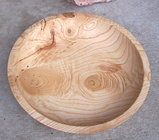
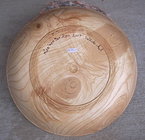
Here is another one, a dried Black Walnut that has 4 knots in it, and one knot did split some.
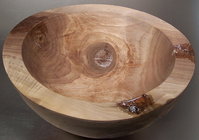
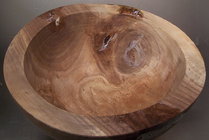
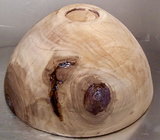
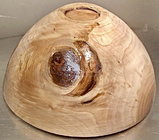
From a whole batch of White Ash bowls there were 3 with knots and one with bark inclusion where the fork had started, this is from when they had come out of the paper bags and were dried.
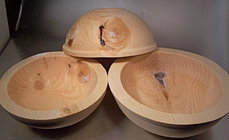
Thanks Leo, will add that to my drying program, have some really nice looking bowl blanks with knots, really like to save them if possible.
You sure put a pretty surface on those bowls, I'm learning.
I've only coated to cure large pieces once and that was some sycamore. According to the guys here, that wood had ring shake really bad so the pieces I cut were 8 to 10 inches from the pith. The tree was 36 to 40 inch in diameter. I did not store those long term on purpose, those pieces are at the old house and I just have not brought them over.
After a sycamore discussion on the forums, I turned a piece of that 10 year old wood, ended up with a 15 inch bowl. I turned it rough even though it is old, just measured the bowl and it is 3/16 inch out of round. To me that is not much movement for a 15" bowl. Going to give it another month or so, see what it does, I'm curious now how much movement I will get as weather changes and spring turns to summer, my test bowl...
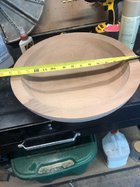
You sure put a pretty surface on those bowls, I'm learning.
I've only coated to cure large pieces once and that was some sycamore. According to the guys here, that wood had ring shake really bad so the pieces I cut were 8 to 10 inches from the pith. The tree was 36 to 40 inch in diameter. I did not store those long term on purpose, those pieces are at the old house and I just have not brought them over.
After a sycamore discussion on the forums, I turned a piece of that 10 year old wood, ended up with a 15 inch bowl. I turned it rough even though it is old, just measured the bowl and it is 3/16 inch out of round. To me that is not much movement for a 15" bowl. Going to give it another month or so, see what it does, I'm curious now how much movement I will get as weather changes and spring turns to summer, my test bowl...

Last edited:
I agree! I weigh the rough turned bowl and write the result and date on the rim. I repeat this at ~one month intervals until the weight barely changes.seems like the 'one year per inch' idea ought to be retired. Life and wood is always way more complicated than the rules-of-thumb we want to live by.
Humidity levels are generally on the low side here, especially in the winter, so I often finish turn a medium to large bowl in 6-7 months.
Another reason for giving up on locally grown oak is that, despite using sharp tools, I often got long-grain tear out, even when using a gouge with an "Irish grind"
in a shear cutting mode. To overcome this, I have had to resort to using a water-based, wood hardener.
in a shear cutting mode. To overcome this, I have had to resort to using a water-based, wood hardener.
Thank you to the gentlemen who responded to my inquiry about cracking of small ornaments.
Nice enough bowl Marvin, I did turn a large Sycamore bowl, but had quite a battle to get it to a turning size, kind of a long story.Thanks Leo, will add that to my drying program, have some really nice looking bowl blanks with knots, really like to save them if possible.
You sure put a pretty surface on those bowls, I'm learning.
I've only coated to cure large pieces once and that was some sycamore. According to the guys here, that wood had ring shake really bad so the pieces I cut were 8 to 10 inches from the pith. The tree was 36 to 40 inch in diameter. I did not store those long term on purpose, those pieces are at the old house and I just have not brought them over.
After a sycamore discussion on the forums, I turned a piece of that 10 year old wood, ended up with a 15 inch bowl. I turned it rough even though it is old, just measured the bowl and it is 3/16 inch out of round. To me that is not much movement for a 15" bowl. Going to give it another month or so, see what it does, I'm curious now how much movement I will get as weather changes and spring turns to summer, my test bowl...
View attachment 44522
It was 30"D x 36"L, and quite heavy for me to load and handle it all by myself, then when I got it home the job of slicing it in two halves was a battle, as I found out when finally done with that, probably kids had made a "fort" and nailed a piece of canvas onto the tree, several years before, long gone, but I found some rests still inside the log, and yes enough nails of all kinds to have kept it on, chainsaw lost a tooth and I had to use metal sawing tools to finish the job, anyway I ended up with a 20" bowl that has some scars with bark in the wall.
All from that one log !
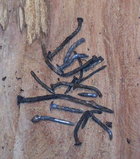
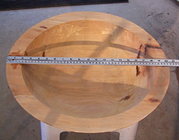
I have turned a few more pieces of Sycamore, to me it is a lot like soft Maple wood, works fine and never had any problems with it, actually that is typical for softer wood, harder wood will give you problems more often.
Very overly large logs do get sometimes what they call spiderweb in the log, I have found that once or twice, and you really have to watch for those, they are hard to find/see.
Here are a couple more Sycamore turnings I made.
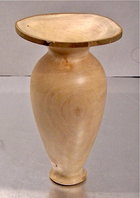
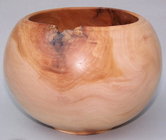
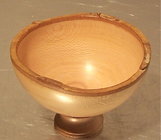
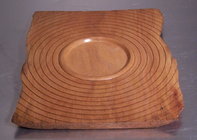
Last edited:
That's a load of nails Leo, those are really nice finished pieces, that natural edge bow must have come from a large chunk of wood to have an almost flat edge...I've always said the grain of sycamore almost looks like human skin.
Now that I moved the head stock to the end of the lathe, I can put the extension on and bring one of the big pieces over and turn a big bowl off the end, been wanting to try that ever since buying the extension years ago. Some of those chunks are 8 to 10 inches thick, big enough for a 24 or so inch bowl. Don't know what I will do with a bowl that big, but always wanted to turn one...
Years ago I bought an engine hoist to put an engine in a jeep my wife drove into a lake (another story), started to sell it a few times but glad I didn't, have moved my lathe with it and can lift big chunks up and mount them without killing my back and that is how I will put that piece of sycamore on the lathe...
Now that I moved the head stock to the end of the lathe, I can put the extension on and bring one of the big pieces over and turn a big bowl off the end, been wanting to try that ever since buying the extension years ago. Some of those chunks are 8 to 10 inches thick, big enough for a 24 or so inch bowl. Don't know what I will do with a bowl that big, but always wanted to turn one...
Years ago I bought an engine hoist to put an engine in a jeep my wife drove into a lake (another story), started to sell it a few times but glad I didn't, have moved my lathe with it and can lift big chunks up and mount them without killing my back and that is how I will put that piece of sycamore on the lathe...
Better yet would be to not do any further cutting until you are ready to rough turn then Anckor seal or brown paper bag it.Moral of the story is, even after 25 years, in a humid climate, seal your ends.
- Joined
- Jan 27, 2005
- Messages
- 13,018
- Likes
- 5,425
- Location
- Dalworthington Gardens, TX
- Website
- pbase.com
I always follow with interest and with a smile the threads here and all over social media about drying wood. Books can be written about all the methods people use to store wood, to dry rough turned blanks. To spalt the wood, and more. I'm blessed where I live a few miles from the Island's rainforest, so I have no problem drying wood, is always humid. But, I had something happen that I wanted to share. Believe it or not, I still have some of the original Koa that got me into woodturning. That was well over 25 years ago. Just about every branch was curly, it was a Big Island Koa, growing in my yard. I cut up a nice log into 3 sections to make Urns. Endgrain turning. I normally would have sealed the ends with Anchor seal. But, I figure this tree is super dry. At one inch per year, is more than dry. Within a few days, the end grain cracked. Just like a green freshly cut log would. Moral of the story is, even after 25 years, in a humid climate, seal your ends.
I think that ithe piece of Koa that I got from you several years ago was from the same tree. For some reason I neglected to seal it with Anchorseal. That was just before my coronary bypass surgery. A few months later I noticed that the ends were splitting, but I still didn’t seal it. While thinking about what to make and then finally deciding on a Hawaiian calabash design a few months later I discovered that the the wood had split all the way from end to end. At first I thought about pewa patches,but it would be rather risky roughing it out. So, maybe a Hawaiian pepper and salt mill set.

